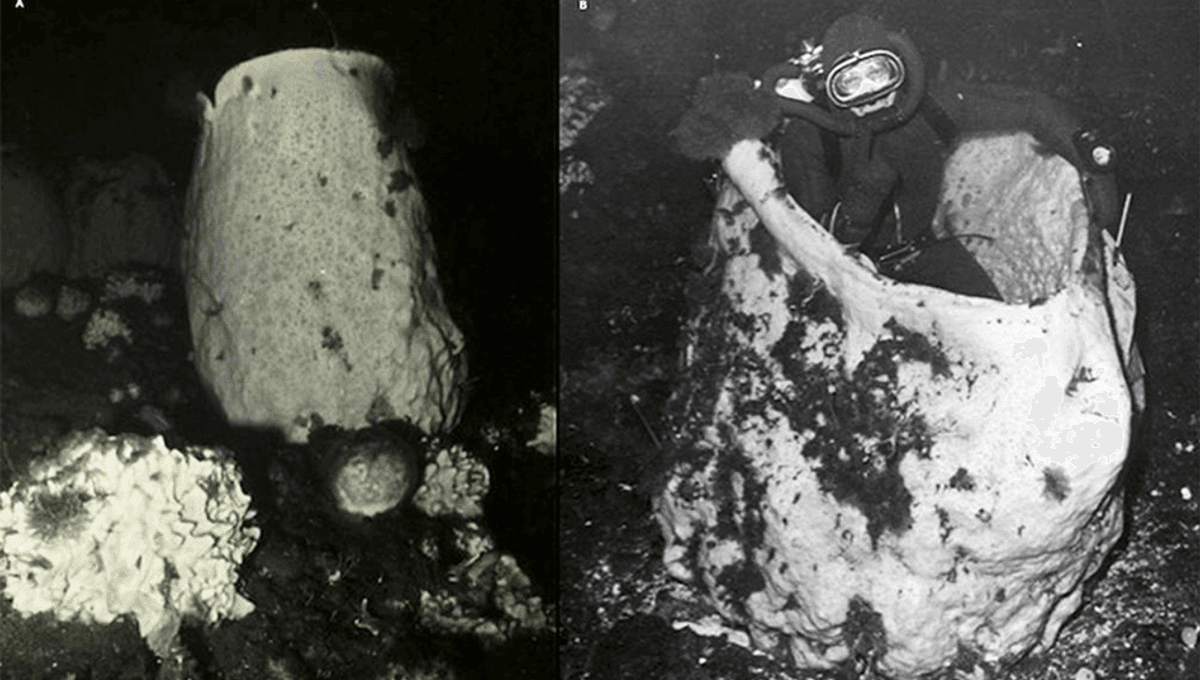
In the McMurdo Sound region of Antarctica, there lives a species of sponge known as the giant volcano sponge (Anoxycalyx joubini). Though aging the individual animals is troublesome, they may be amongst the oldest animals on the planet.
ADVERTISEMENT GO AD FREE
Sponges, though not the most thrilling of animals in terms of their shenanigans, are pretty interesting creatures. The immobile invertebrates, like corals, form an important part of the ecosystems they inhabit, as well as providing shelter for other, smaller animals. They are also a lot hardier than you might expect.
“A sponge’s skeletal type adapts well to its particular habitat, allowing it to live on hard, rocky surfaces or soft sediments such as sand and mud. Some sponges even attach themselves to floating debris! Rarely are they found completely free-floating,” the National Oceanic and Atmospheric Administration (NOAA) explains.
“As water filters through a sponge’s porous exterior, the sponge gains some motion, receives food and oxygen, and dispels waste. Inside the sponge, tiny hairlike structures called flagella create currents to filter bacteria out of the sponge’s cells and trap food within them. Their strong skeletal structures help sponges withstand the high volume of water that flows through them each day.”
As well as potentially being the first animals to emerge on the planet, sponges may lay claim to being the oldest living residents.
Anoxycalyx joubini can grow up to 1.5 meters (5 feet) in diameter and 1.95 meters (6.5 feet) in height, living at depths of between 15 meters (49 feet) and 144 meters (472 feet). A bit like looking at tree growth rates to estimate their age, or guessing a toddler’s age from their height, scientists have attempted to estimate the age of individuals of the species based on how fast they grow. And, it turns out that through measuring them over a 22-year period, A. Joubini takes a long time to grow.
ADVERTISEMENT GO AD FREE
“Anoxycalyx joubini is the largest and most conspicuous sponge in the Antarctic and although it has been observed as much as 2 m [6.6 feet] in height, it has never been observed to settle or grow,” one team explains, “which has led to estimates of extreme longevity.”
Contributing to this long lifetime could be the consistent, cold environment, which also serves to slow down the animal’s metabolism.
One individual was found to be around 23,000 years old, according to that team’s growth models, with upper estimates saying that the animals, also known as Scolymastra joubini, could live as long as 40,000 years. However, those ages might be a little on the high side, according to further analysis.
“Operating on such times-scales one has to think not only of biological implications but also consider geological events. Fluctuations of the sea level associated with the last glacial maximum (LGM -18,000-22,000 years ago) will probably have left the site of the 2m-S. joubini ‘high and dry’ as the sea level during the LGM was 105-130m [345-427 feet] lower than today. It can therefore be concluded that no marine invertebrate on the Ross Sea shelf can be older than ~15,000 years,” marine biologist Dr Susanne Gatti explained in a 2002 paper.
ADVERTISEMENT GO AD FREE
“Nevertheless, we have to conclude, that hexactinellid sponges in Antarctica are among the oldest if not the oldest living creatures on this planet,” Gatti continued. “Even if the 2m high S. joubini in the Ross Sea was only half the age suggested by growth curve it would still be > 6,000 years old and hence the oldest living creature not only in the ocean but also compared with terrestrial life.”
Source Link: Anoxycalyx Joubini: This Giant Volcano Sponge Found In Antarctica May Live For 15,000 Years